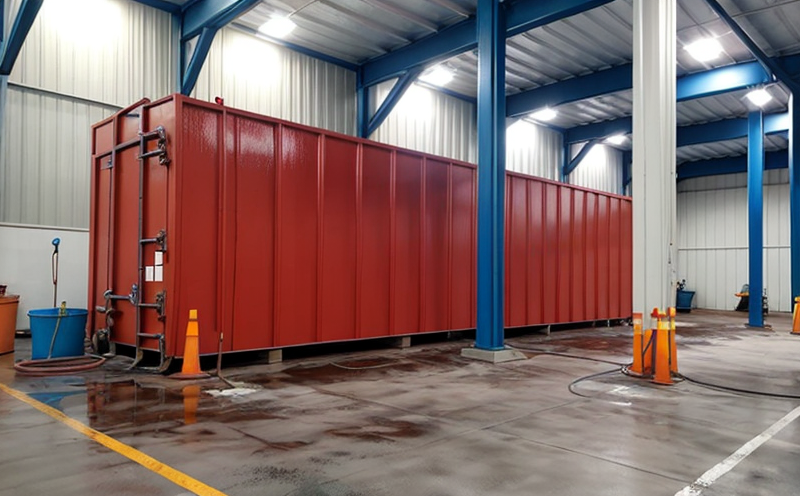ASTM G87 Moist SO₂ Corrosion Testing of Coated Metals
The ASTM G87 standard is a pivotal method for evaluating the resistance of coated metals to moist sulfur dioxide (SO₂) corrosion. This testing protocol is particularly crucial in industrial manufacturing and processing where materials are exposed to harsh environmental conditions, including high humidity and corrosive gases like SO₂.
Moisture plays a significant role in enhancing the corrosiveness of SO₂. In environments where moisture levels are high, such as in chemical plants or areas with heavy industrial activity, understanding how coatings perform under these conditions is critical for ensuring product longevity and reliability.
The ASTM G87 method simulates an environment rich in water vapor and SO₂ to test the performance of coatings applied to metals. This testing protocol is essential because it helps manufacturers ensure that their products can withstand real-world conditions, thereby reducing maintenance costs and extending service life. The test involves exposing coated specimens to a controlled atmosphere containing 15% relative humidity and 300 ppm SO₂ for an extended period.
Materials used in industrial environments often face severe challenges due to the presence of corrosive gases like sulfur dioxide. These conditions can lead to degradation, which may compromise the integrity of equipment and infrastructure. By utilizing ASTM G87 testing, industries can identify coatings that not only adhere well but also resist corrosion effectively under moist SO₂ conditions.
The process involves careful preparation of specimens before exposure to the test atmosphere. This includes cleaning, degreasing, and ensuring that the coating is intact and adhered properly. Once prepared, the specimens are placed in a chamber where they are exposed to the specified atmospheric conditions for a predetermined duration. After testing, samples undergo inspection to assess their resistance to corrosion.
ASTM G87 provides detailed guidelines on how to conduct this test accurately and reliably. Compliance with these standards ensures that results are comparable across different laboratories, contributing to more robust data and improved product quality. The method's rigidity also helps in identifying coatings that can withstand harsh environmental conditions effectively, promoting better decision-making for material selection.
Understanding the nuances of ASTM G87 is vital not only for compliance but also for optimizing performance in various industrial applications. By adhering to this standard, manufacturers can ensure that their products are durable and reliable, even under challenging conditions. This aligns with broader industry goals towards sustainability by reducing waste and extending product lifecycles.
In summary, ASTM G87 Moist SO₂ Corrosion Testing of Coated Metals is a vital tool for ensuring the durability and longevity of industrial materials exposed to moist SO₂ environments. It plays a crucial role in maintaining high standards of quality and reliability across various sectors, from chemical processing plants to automotive manufacturing.
Scope and Methodology
The scope of ASTM G87 encompasses the evaluation of the resistance of coated metals to moist sulfur dioxide (SO₂) corrosion. This test is specifically designed for materials that may be exposed to environments rich in water vapor and SO₂, which are common in industrial manufacturing processes.
According to ASTM G87, the testing procedure involves exposing specimens to controlled atmospheric conditions containing 15% relative humidity and 300 ppm SO₂. Specimens must remain under these conditions for a minimum of 96 hours but can be extended based on specific requirements or standards set by regulatory bodies.
The methodology emphasizes the importance of specimen preparation, which includes cleaning, degreasing, and ensuring that the coating is intact and adhered properly. Proper preparation ensures accurate results and consistency across different tests.
During testing, specimens are placed inside a chamber designed to maintain the specified atmospheric conditions. The test duration can vary depending on the desired outcome or specific requirements of the industry in question. After exposure, samples undergo inspection to assess their resistance to corrosion based on predefined criteria.
The ASTM G87 method is not only rigorous but also flexible enough to accommodate various testing scenarios. It provides detailed guidelines that ensure accurate and reliable results, making it a trusted standard for quality assurance across the industrial sector.
- Specimen preparation: Cleaning, degreasing, ensuring coating adhesion.
- Atmospheric conditions: 15% relative humidity, 300 ppm SO₂.
- Test duration: Minimum of 96 hours, extendable based on requirements.
- Inspection post-exposure to evaluate resistance to corrosion.
The meticulous nature of ASTM G87 ensures that it remains a reliable method for evaluating the performance of coatings in moist SO₂ environments. This standard is widely used by quality managers, compliance officers, R&D engineers, and procurement teams who need accurate data to make informed decisions about material selection and product design.
Industry Applications
- Chemical Processing Plants: Ensures the durability of equipment exposed to high humidity and corrosive gases like SO₂. This is crucial for maintaining operational efficiency and safety.
- Automotive Manufacturing: Evaluates coatings used in exhaust systems, which are often exposed to harsh environmental conditions that include moisture and corrosive substances.
- Power Generation Facilities: Helps assess the longevity of materials used in cooling towers and other components where high humidity levels are prevalent.
- Mining Industries: Ensures that equipment handling sulfur-rich compounds is protected against corrosion, enhancing operational reliability and safety.
- Petrochemical Plants: Guarantees that process piping and storage tanks remain intact in environments rich in water vapor and SO₂.
- Offshore Oil Platforms: Evaluates coatings used on structures exposed to high humidity and corrosive sea air, ensuring the integrity of offshore facilities.
These applications highlight the importance of ASTM G87 in various sectors where materials must withstand severe environmental conditions. By adhering to this standard, industries can ensure that their products are reliable and long-lasting, thus contributing to overall operational efficiency and safety.





